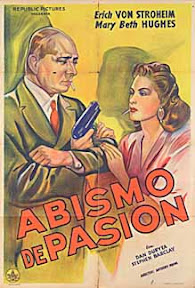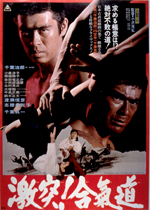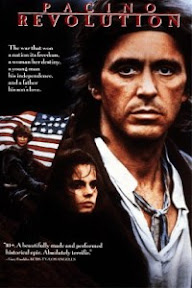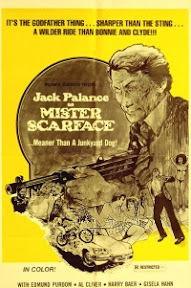 One of director Anthony Mann's first films, this adaptation of a Vicki Baum short story is one of the last starring roles for Erich Von Stroheim. This is an early film noir and in it the 60 year old Stroheim plays the sort of role Edward G. Robinson was playing in films like Scarlet Street and The Woman in the Window. As if to establish the ground rules of the rising genre, established heavies like Robinson and Stroheim (the erstwhile "Man You Love to Hate") are thrown like raw meat to the new monster in Hollywood, the femme fatale. In the case of Stroheim's acting career, Flamarion is like a noir do-over of his first talking role, The Great Gabbo, with the balance of power decisively shifted from the imperious showman to his flirtatious protege.
One of director Anthony Mann's first films, this adaptation of a Vicki Baum short story is one of the last starring roles for Erich Von Stroheim. This is an early film noir and in it the 60 year old Stroheim plays the sort of role Edward G. Robinson was playing in films like Scarlet Street and The Woman in the Window. As if to establish the ground rules of the rising genre, established heavies like Robinson and Stroheim (the erstwhile "Man You Love to Hate") are thrown like raw meat to the new monster in Hollywood, the femme fatale. In the case of Stroheim's acting career, Flamarion is like a noir do-over of his first talking role, The Great Gabbo, with the balance of power decisively shifted from the imperious showman to his flirtatious protege.Mann and his writers immediately turn Stroheim against type by introducing him as a disheveled, dying man lurking about backstage as a Mexico City vaudeville show of 1936 breaks down amid sounds of gunfire. The wife and partner of a trick bicyclist has been killed, and the bicyclist is the prime suspect. But as the once-great Flamarion tells the last actor in the theater, after the cops have left, he is the killer -- and in proper noir flashback style, he proceeds to explain why.
The Great Flamarion was a trick-shot artist with a unique comedy-act gimmick. His act has him burst in upon an actress playing his wife, who he finds cheating on him. Provocatively for the time, he seems prepared to shoot his wife's clothes off before her paramour attempts his escape. The role of the paramour requires a dancer's agility, for he must dodge Flamarion's real bullets as the star shoots out the lights on a mirror behind the man. The paramour, Al Wallace (Dan Duryea in a very William H. Macy type role) is actually the husband of Flamarion's stage wife (Mary Beth Hughes), but theirs is an unhappy partnership. Al's an alky, but he has dirt on Connie that keeps her from breaking up the partnership. She also has the hots for the bicyclist she'll eventually marry. How to get free? Connie's plan is to work on the cold, teutonic Flamarion and soften him up. It'll take a while, but it'll get Al jealous enough to provoke a situation in which the eminently qualified Flamarion can eliminate Mr. Wallace. The beauty of the scheme is that she'll take advantage of Al's alcoholism to get Flamarion off the hook. He shoots Al deliberately, but a coroner's inquest determines on the basis of Al's drinking that the victim caused his own death by mistiming his steps on stage. Her deal with Flamarion is that, after a decent interval of mourning (three months), they'll hook up in Chicago and she'll marry him. Believe it...or not.The Great Flamarion, after and before.
In retrospect, it might have made more sense for Connie to set things up to make Flamarion's attack look more blatantly like murder. That way he'd be in jail, or dead, but as things develop, once he figures out (it takes a while, the sap) that he's been jilted and dumped, he sacrifices his career and wealth in order to track her down. He finally has to sell all but one of his guns to afford a ticket to the show in Mexico where he finds her at last. True to form, Connie seems poised to dump the bicyclist for an acrobat before Flamarion intervenes.Mary Beth Hughes rarely got out of B-movies, but for Flamarion she deserves a spot in the Femme Fatale Hall of Fame.
The Great Flamarion takes the flashback framing device to an absurd extreme, giving us a detailed narrative related by an old man on the brink of bleeding to death after falling from a catwalk. By backdating the climax to 1936, the writers seem to acknowledge that the vaudeville story was somewhat dated for Forties audiences. The film's femme fatale is a misogynist nightmare of wily femininity chewing up and spitting out successive male victims; even this early in the noir game cliche threatens to overtake social or psychological realism. But the movie is still worth watching for Mann's maturing visual style and Stroheim's iconoclastic performance. The actor starts off (in the flashback, that is) playing the predictable barking martinet, but as he responds to Hughes Stroheim reveals a reticent vulnerability that wins your sympathy. Unlike his archetypal jaded or decadent sophisticate, Flamarion is a once-bitten, twice-shy sort whose gruff manner is all about protecting himself from forming emotional attachments that might hurt him -- a wise approach, we might decide in retrospect. Stroheim loosens up quite a bit along the way, even dancing with himself at one point in anticipation of his reunion with Connie. It's an underrated performance that should serve as proof that the man history remembers as a director victimized by Hollywood has never really gotten enough credit as an actor.
Meanwhile, Mann was entering a phase where practically everything he shot helped define the visual look of noir. His effects range from the expressionistic (the bicyclists' shadows behind the curtain as Connie seduces yet another man) to the show-offish (characters often talk to people who are only seen in mirrors), and they give this film a style probably unequaled in any other 1945 release from Republic Pictures.
This is the earliest Mann film that I've seen and I can see the qualities in it that made him one of my favorite directors. It's a minor film in his filmography but one worth watching for fans of him or Stroheim.






